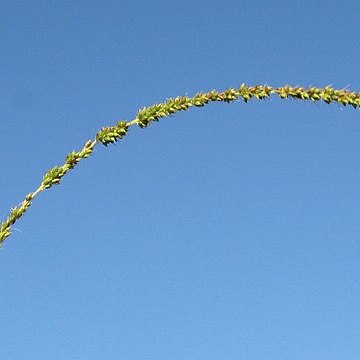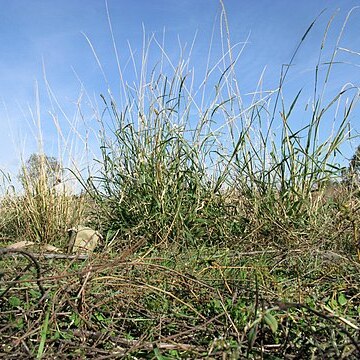Tufted perennial 300-2000 mm high; rhizome short, oblique, creeping, not robust; basal sheaths straw-coloured to light brown or reddish; culm node hairy, rarely glabrous. Leaf blade 150-600 x 3-14 mm. Inflorescence spike-like, tapering towards apex, often interrupted at base; bristles several, 2-15 mm long, scaberulous, slender, usually tapering to apex, green, often with purple. Spikelet 2.5-3.0(-3.7) mm long; lower glume 3-nerved; upper glume (5)7-9(-11)-nerved; lower lemma firmly membranous; upper lemma punctate to obscurely rugose.
Perennial; up to 2 m high; with oblique creeping rhizome and tufted. Culm nodes hairy. Leaf blades 150-600 x 3-14 mm; basal sheaths straw coloured to light brown or reddish. Flowers: panicle spike-like; tapering at apex; often interrupted in lower part; spikelets 2.5-3.0(-3.7) mm long; bristles several; upper glume (5)7-9(-11)-nerved.
Perennial, rhizomatous and tufted (with an oblique creeping rhizome), up to 2 m high. Leaf blades 150-600 mm long, 3-14 mm wide. Basal parts showing a reddish straw colour. Culm nodes hairy. Spikelets 2.5-3.0 (-3.7) mm long. Panicle spike-like, tapering towards tip, often interrupted in lower part; lower glume 3-nerved.
Panicle 3–30 cm. long, spiciform, cylindrical or somewhat irregular, spikelets and bristles typically pallid green often with purple tips and sometimes wholly purple, the rhachis tomentellous to sparsely pilose; bristles 2–15 mm. long, in bundles of c. 4, tapering and scaberulous to the tip.
Rhizomatous perennial to 2 m, culm nodes pubescent. Leaves linear. Spikelets 2.5-3 mm long, in a contracted spike-like panicle often interrupted below, bristles 4-10 per cluster, lower glume 3-nerved.
Culms 20–200 cm. high, the nodes pubescent though the hairs sometimes fugacious, rarely glabrous (see note); basal sheaths pallid to light brown.
A herb. It is a grass that forms dense tufts and keeps growing from year to year. It has rhizomes or underground stems. It grows 2 m high.
Spikelets 2–3(4) mm. long, broadly ovate to gibbously suborbicular, laterally compressed.
Inferior glume 1/3–2/3, the superior f to as long as spikelet and (5)7–9(11)-nerved.
Inferior floret male, its lemma firmly membranous.
Tufted perennial, arising from a short rhizome.
Superior lemma punctate to obscurely rugose.


